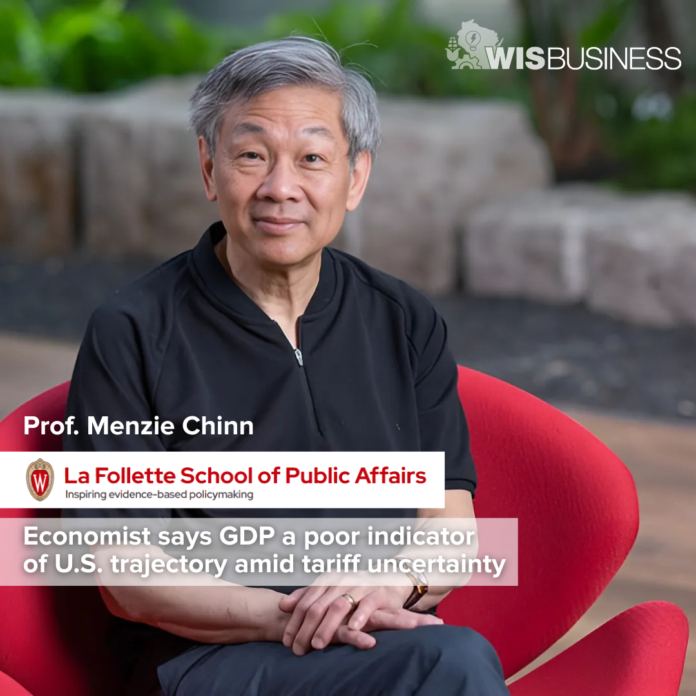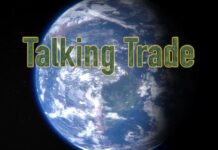An economist with UW-Madison says GDP growth is a poor indicator of the economy’s current trajectory, as other factors suggest a national slowdown amid tariffs and related uncertainty.
Menzie Chinn, a professor in the university’s La Follette School of Public Affairs, discussed this topic during the latest Wisconsin Foundation and Alumni Association UW Now livestream. His recent remarks came after federal figures were released showing national GDP grew 3% in the second quarter of this year, following a decline of 0.5% in the first quarter.
While he said this figure may look like a great recovery, it remains below where it would be if the national economy kept up with the 2023-2024 projected trend.
“So GDP jumped up, but you can see what’s going on is, GDP is being whipsawed all around by people changing their behavior in response to these unprecedented tariffs,” Chinn said, adding “now traffic into the ports is decreasing as we’re cutting back, as the price of imports has risen.”
He referenced other economic factors that point to a possible slowdown, including a recent decline in personal income following more than two years of growth. An employment survey that taps households rather than employers also found a recent decline. Plus, national nonfarm employment growth was recently revised downward, undercutting earlier conclusions about the strength of the economy.
“It’s the previous months that were revised downwards, so that in some you had like a quarter million jobs creation erased, and so what we thought was a fairly strong economy is now looking a little lackluster if not struggling,” he said.
By contrast, industrial production is “the only thing that’s really solidly going up” in early 2025, Chinn said, but he added this only represents about 17% of the economy.
Ultimately, a growing body of evidence shows the economy is slowing — the question is, he said, will that continue and tip the economy into a recession, or not?
“That’s why, in part, this issue about the tariffs is so critical at this time … if you get hit by tariffs, that’s going to tend to make everything more expensive, it’s also going to tend to make it harder for us to export,” he said. “And so you can see, a bunch of things that could push the economy from what’s still growing in some components, in some areas, into something that’s going into a tailspin.”
Also during the livestream, UW-Madison Assistant Prof. Lydia Cox pointed to figures showing U.S. import prices haven’t fallen since tariffs were imposed earlier this year. That’s based on records of import prices excluding tariffs.
“What that tells us is that it’s not the foreign countries that are paying for these tariffs, but somebody in the U.S. is paying those costs,” she said.
Cox also noted both the Consumer Price Index and Producer Price Index — which measures the prices firms pay — have been rising in recent months. That shows U.S. businesses are already seeing price increases and are starting to pass those higher costs onto consumers, she explained.
“In the most recent month of data, what we saw is that things like appliances and apparel, those are some of the categories where prices are increasing the most,” she said. “And these are of course goods that we import a lot from China … this is all kind of confirming what we expected to see, the tariffs putting pressure on prices is starting to materialize.”
After the latest monthly jobs report was weaker than expected, President Donald Trump fired Bureau of Labor Statistics Commissioner Erika McEntarfer, arguing the numbers were “rigged.” But Chinn said multiple investigations have found the BLS figures are trustworthy, adding the agency should hire more workers in order to deliver better estimates.
While he said federal budget cuts as well as the trend of fewer people answering their phones have likely made it harder to get accurate employment estimates, “nobody who’s credible believes that the numbers are rigged.”
Chinn also said “so many economists are worried” given the record-high levels of uncertainty about federal policymaking.
“In terms of policy uncertainty, it’s as high as during the pandemic,” he said. “In terms of trade uncertainty, it’s higher than anything that’s been recorded that we know. So to the extent that tariffs and uncertainty are weighing down on growth, that’s going to mean that the future is incredibly misty.”
Watch the video.






